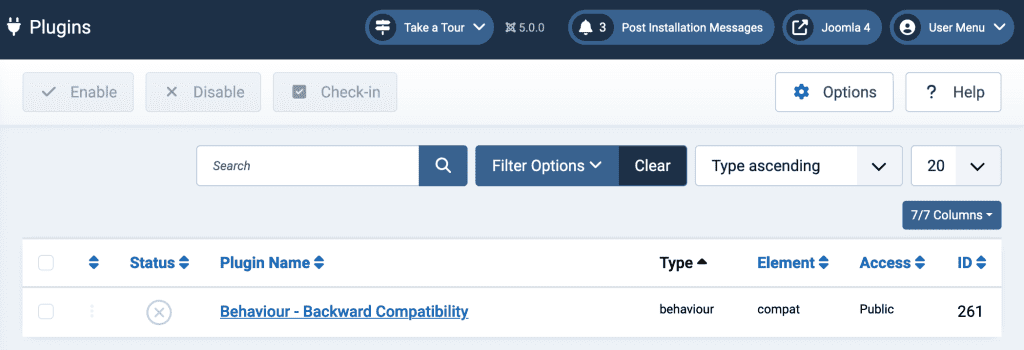Behaviour – Backward Compatibility Plugin for Joomla: A Complete Guide

With Joomla 5.0, the developers introduced an essential plugin to enhance backward compatibility between versions 5 and 4. This plugin, implemented as the "Behaviour" type, ensures it loads before any other plugins. Such prioritization ensures that core functionalities relying on older code structures aren't disrupted as new updates roll out.
Note: Although the plugin is of the "Behaviour" type, developers should exercise caution when creating new plugins of this type. Future Joomla versions might phase out this group, making it obsolete.
The Three Pillars: Plugin Options
The compatibility plugin comes with three distinct options that super users can activate:
- The first option deals with class aliases, some of which have roots in Joomla 1.0. While they've been getting deprecated and replaced since Joomla 3.3, this option ensures that older extensions relying on them don't break.
- The second and third options relate more to legacy web assets. For most use-cases, these can be safely disabled without causing disruptions.
After migrating from Joomla 4.4 to 5.x, the plugin is automatically enabled, with all options active. This automatic activation also extends to new installations of Joomla 5.0 and possibly later versions.
Purpose and Long-Term Vision
The primary goal of this plugin is twofold:
- Facilitate a seamless transition from Joomla 4.4 to 5.
- Allow the installation of non-updated Joomla extensions in Joomla 5.
This strategy grants developers an additional two years to align old code with current standards. However, it's essential to note that Joomla 6 plans to remove deprecated code, emphasizing the temporary nature of this plugin.
Performance Implications
While the plugin serves a noble purpose, it does come with a minor drawback: added page load times. This increase in load time is due to the additional code the plugin introduces to ensure compatibility.
What if we disable the Behaviour - Backward Compatibility Plugin?

If you disable the Behaviour - Backward Compatibility Plugin in Joomla, several things can happen, based on the information provided:
- Loss of Class Aliases Support: The first option of the plugin deals with class aliases. These are older class names that have been renamed in newer Joomla versions but are kept for backward compatibility. If your site or any extensions on your site rely on these old class names, disabling the plugin can cause those parts of the site to break or malfunction.
- Legacy Web Assets: The second and third options of the plugin deal with legacy web assets. If any extension on your site relies on these legacy web assets, there could be potential disruptions. However, based on the provided information, it's mentioned that it's relatively safe to disable these options as it's unlikely for extensions to load a legacy web asset directly.
- Extension Compatibility Issues: Extensions that haven't been updated for Joomla 5 might rely on deprecated features that the compatibility plugin supports. Disabling the plugin could result in these extensions malfunctioning or causing errors on your site.
- Performance Improvements: On the upside, since the plugin loads additional code to ensure compatibility, disabling it might result in a slight improvement in page load times. This could lead to a faster website experience for your users.
- Future-Proofing: If you can successfully run your website with the plugin disabled, it suggests that your site and extensions are more in line with the newer standards of Joomla. This is beneficial as you prepare for future Joomla versions, especially considering that Joomla 6 plans to remove deprecated code.
Recommendations:
Before disabling the plugin:
- Backup: Always ensure you have a recent backup of your website. This allows you to restore your site if something goes wrong.
- Test in a Staging Environment: If possible, test the changes in a staging or development environment first. This way, you can see the effects without impacting your live site.
- Monitor After Disabling: After you've disabled the plugin, thoroughly test all aspects of your site to ensure everything is working as expected.
While the Behaviour - Backward Compatibility Plugin provides a bridge for older extensions and functionalities, it's crucial to ensure that your site and its extensions evolve with Joomla's changes. If you decide to disable it, do so with caution and preparation.
Final Thoughts and Recommendations
Transition periods in software development can often be tumultuous. However, tools like the Behaviour - Backward Compatibility Plugin are a testament to Joomla's commitment to its vast user base. Developers are urged to test their extensions with the compatibility plugin disabled, ensuring future-proofing their products.




